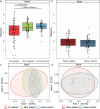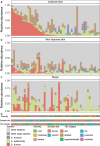Skin Microbiome in Patients with Hand Eczema and Healthy Controls: A Three-week Prospective Study
- PMID: 34877605
- PMCID: PMC9631265
- DOI: 10.2340/actadv.v101.845
Skin Microbiome in Patients with Hand Eczema and Healthy Controls: A Three-week Prospective Study
Abstract
The pathogenesis of chronic hand eczema remains unclear. Insights into the skin microbiome in hand eczema and its potential relevance to disease severity may help to elucidate the underlying mechanisms of hand eczema. The aim of this study was to characterize the microbiome in patients with hand eczema and healthy controls. A 5-visit prospective study was conducted over a period of 3 weeks. At each visit, bacterial swabs were taken from the hands of patients with hand eczema and controls. The microbiome was examined using DNA extraction and 16S rRNA amplicon sequencing (V3-V4 regions). Fifty patients with hand eczema and 50 controls were included (follow-up rate=100%). The baseline bacterial α-diversity was reduced on the hands of patients with hand eczema compared with controls (effect size=-0.31; 95% confidence interval (95% CI) -0.50; -0.11; p = 0.003). The dysbiosis on the patients' hands was stable over the study period, was associated with disease severity, and was characterized by reduced bacterial diversity and different bacterial community compositions.
Conflict of interest statement
Figures




References
-
- Quaade AS, Simonsen AB, Halling AS, Thyssen JP, Johansen JD. Prevalence, incidence and severity of hand eczema in the general population – a systematic review and meta-analysis. Contact Dermatitis 2021; 84: 361–374. - PubMed
-
- Agner T, Elsner P. Hand eczema: epidemiology, prognosis and prevention. J Eur Acad Dermatol Venereol 2020; 34: 4–12. - PubMed
-
- Haslund P, Bangsgaard N, Jarlov JO, Skov L, Skov R, Agner T. Staphylococcus aureus and hand eczema severity. Br J Dermatol 2009; 161: 772–777. - PubMed
-
- Mernelius S, Carlsson E, Henricson J, Lofgren S, Lindgren PE, Ehricht R, et al. . Staphylococcus aureus colonization related to severity of hand eczema. Eur J Clin Microbiol Infect Dis 2016; 35: 1355–1361. - PubMed
-
- Nørreslet LB, Edslev SM, Andersen PS, Plum F, Holt J, Kjerulf A, et al. . Colonisation with Staphylococcus aureus in patients with hand eczema: prevalence and association with severity, atopic dermatitis, subtype and nasal colonisation. Contact Dermatitis 2020; 83: 442–449. - PubMed
MeSH terms
Substances
LinkOut - more resources
Full Text Sources
Medical

